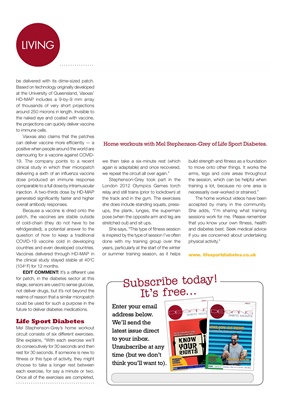
LIVINGLIVING
be delivered with its dime-sized patch.
Based on technology originally developed
at the University of Queensland, Vaxxas'
HD-MAP includes a 9-by-9 mm array
of thousands of very short projections
around 250 microns in length. Invisible to
the naked eye and coated with vaccine,
the projections can quickly deliver vaccine
to immune cells.
Vaxxas also claims that the patches
can deliver vaccine more efficiently - a
positive when people around the world are
clamouring for a vaccine against COVID19. The company points to a recent
clinical study in which their micropatch
delivering a sixth of an influenza vaccine
dose produced an immune response
comparable to a full dose by intramuscular
injection. A two-thirds dose by HD-MAP
generated significantly faster and higher
overall antibody responses.
Because a vaccine is dried onto the
patch, the vaccines are stable outside
of cold-chain (they do not have to be
refridgerated), a potential answer to the
question of how to keep a traditional
COVID-19 vaccine cold in developing
countries and even developed countries.
Vaccines delivered through HD-MAP in
the clinical study stayed stable at 40oC
(104o F) for 12 months.
EDIT COMMENT: It's a different use
for patch, in the diabetes sector at this
stage, sensors are used to sense glucose,
not deliver drugs, but it's not beyond the
realms of reason that a similar micropatch
could be used for such a purpose in the
future to deliver diabetes medications.
Life Sport Diabetes
Mel Stephenson-Grey's home workout
circuit consists of six different exercises.
She explains, "With each exercise we'll
do consecutively for 30 seconds and then
rest for 30 seconds. If someone is new to
fitness or this type of activity, they might
choose to take a longer rest between
each exercise, for say a minute or two.
Once all of the exercises are completed,
we then take a six-minute rest (which
again is adaptable) and once recovered,
we repeat the circuit all over again."
Stephenson-Grey took part in the
London 2012 Olympics Games torch
relay and still trains (prior to lockdown) at
the track and in the gym. The exercises
she does include standing squats, pressups, the plank, lunges, the superman
pose (when the opposite arm and leg are
stretched out) and sit ups.
She says, "This type of fitness session
is inspired by the type of session I've often
done with my training group over the
years, particularly at the start of the winter
or summer training season, as it helps
build strength and fitness as a foundation
to move onto other things. It works the
arms, legs and core areas throughout
the session, which can be helpful when
training a lot, because no one area is
necessarily over-worked or strained."
The home workout videos have been
accepted by many in the community.
She adds, "I'm sharing what training
sessions work for me. Please remember
that you know your own fitness, health
and diabetes best. Seek medical advice
if you are concerned about undertaking
physical activity."
Home workouts with Mel Stephenson-Grey of Life Sport Diabetes.
www. lifesportdiabetes.co.uk
ISSUE 88
DIABETES MAGAZINE
DESANG
MAKING
CARBS
COUNT:
SWEET POTATO
PLUS • Diabetes kit • Giveaways • News (for T1 and T2) • Food News
Access to blood test strips
and meters: your choice
PLUS:
Screen Time
(part 2): meters
Subscribe today!
Enter your email
address below.
We'll send the
latest issue direct
to your inbox.
Unsubscribe at any
time (but we don't
think you'll want to).
It's free...